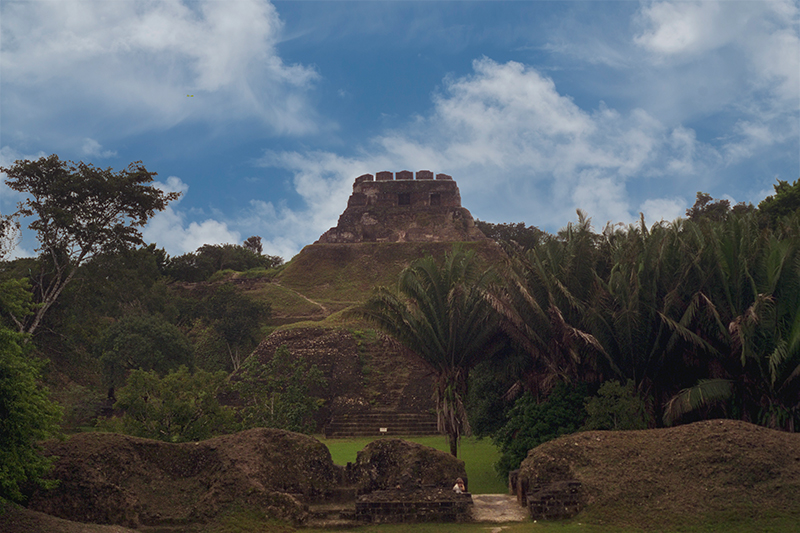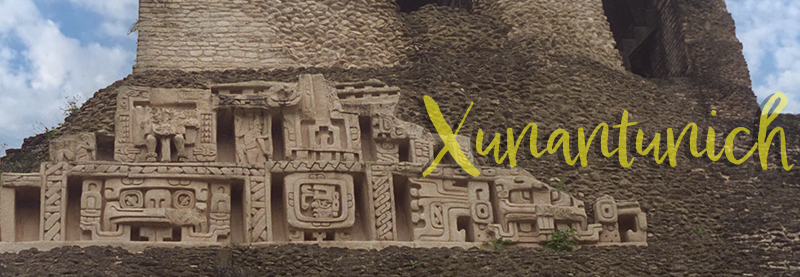

Xunan Tunich means stone woman in Maya, and this is how the local people refer to the site. However, in the reports of old travelers it is generally called Benque Viejo.
"This ceremonial centre is an outlying member of, and on the eastern fringe of, a dense concentration of Maya sites in the eastern part of the Peten district of Guatemala which includes such well-known major sites as Tikal, Uaxactun and Naranjo. After examining the Maya remains in the whole of the Belize river valley, G.R.Willey and others suggested that Xunantunich may in fact have been a fairly important provincial centre, perhaps a regional capital.
Whether this capital of the "Belize valley community" itself owed allegiance to the much larger sites further west is a matter for conjecture. Certainly the fine astronomical carved frieze on the main palace building at Xunantunich should indicate that the priests there were in the main stream of Maya intellectual culture."
Euan W. Mackie, New Light on the End of Classic Maya Culture at Benque Viejo, British Honduras. Published online by Cambridge University Press, 20 January 2017, p. 8.
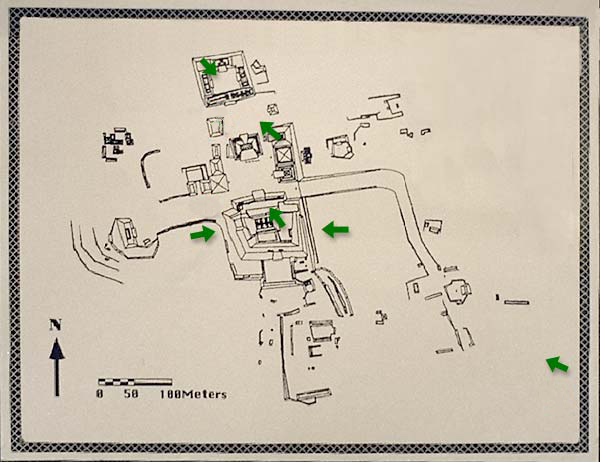
Click on GREEN ARROWS to view photos of major buidings and vistas
Our annotated Xunantunich reading list.
NEW! Subscribe to our free newsletter, MayaRuins Insights
"This new map of Xunantunich was one of the first projects initiated by the Xunantunich Archaeological Project in 1991. It provides a generally complete picture of the architecture within the central precinct of the ancient city."
Lable for map, Xunantunich museum
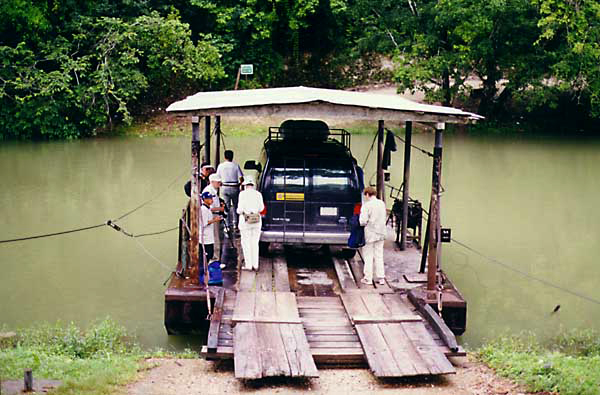
Photo by Jeff Purcell, January 4, 1998
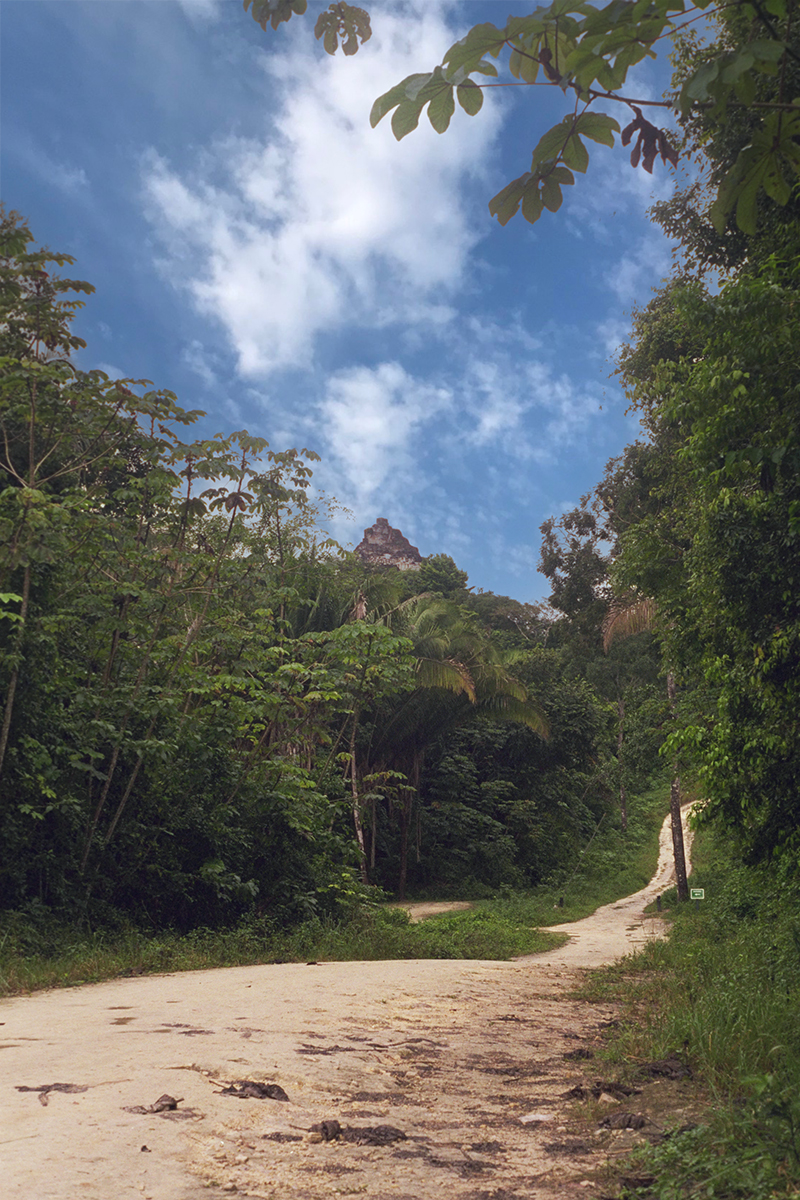
In his 1908 report of explorations for the Peabody Museum at Harvard, Teobert Maler wrote:
"Fortunately my enforced stay in Benque Viejo could be employed in thoroughly exploring a ruin lying on the other side of the river. This ruin is only 2 1/2 km. distant on an air-line, and the principal edifice, "El Castillo de dos Epocas," crowning an eminence, appears from the modern village like a green, wooded height lying to the northwest.
The top of a natural elevation had evidently been levelled off to form a large, rectangular terrace near the edges of which may be seen the remains of small structures, while the centre is occupied by the two-storied main edifice."
Teobert Maler:. Explorations in The Department of Peten, Guatemala And Adjacent Region. Memoirs. Peabody Museum of American Archaeology and Ethnology, Harvard University, Cambridge, MA. 1908, p. 77

Although Benque Viejo by no means matches in size and amount of construction the large ceremonial centers further west in the Guatemalan Department of Peten, its principal building, A-6, a large palace on a high substructure, rises 140 feet (about 50 m.) above the plaza and is one of the most imposing structures in the southern Maya lowlands.
Willey, 1965: 315

"This west frieze was excavated in 1993. In order to preserve the original stucco frieze, a fiberglass replica was made in 1996. The original frieze remains buried and preserved about one meter behind the replica.
The sculptured frieze is attached to the upper part of a large building, A-6-2nd, constructed about 800 A.D. Both the building and frieze were buried by the construction of the final building, A-6-1st. To the right of the frieze, one of the buried door jams of A-6-2nd is visible."
Belize Dept. of Archaeology, sign at the site
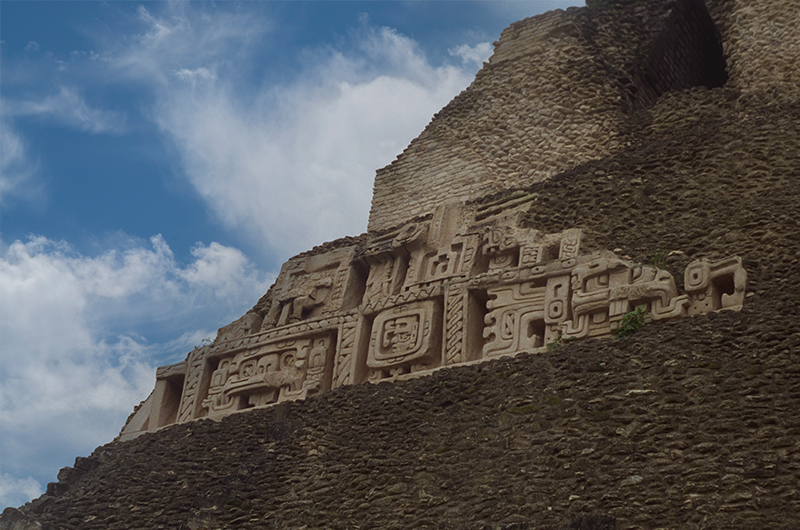
"The frieze originally wrapped around all four sides of Str. A-6-2nd. Today, only fragments on the east and west remain. The rest fell away, probably centuries ago.
The sculpture is divided into two horizontal sections. Symbols representing twisted cord or plaited rope connect all elements of the frieze."
Belize Dept. of Archaeology, sign at site
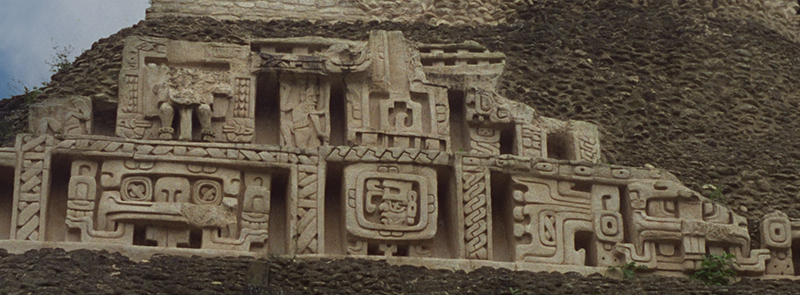
"Only the central and northern masks within the lower register are still visible today on the west frieze. The end mask, with the axes in its eye associating it with the number six, represents the World Tree or Central Axis of the Maya world.
The central mask seems to represent the Maya sun god. Between the masks is a framed profile of an ancestral deity.
In the upper register, a figure seated on a throne is visible. Although badly eroded, this figure probably represents a previous ruler or ancestor marking the lineage of the ruling family at Xunantunich.
A dancing figure is visible next to the ruler. A fragment of a serpent-headed throne can be seen above the central mask. Three rulers or ancestors of the ruling family were probably portrayed on all sides of this building, each seated in a niche or atop a throne."
Belize Dept. of Archaeology, from sign at site

This part of the frieze was first found and excavated in 1950. The sculpted frieze is attached to the upper part of a large building, A-6-2nd, constructed about 800 A.D. Both the building and the frieze were buried by the construction of the final building, A-6-1st.
Photo by Juan José Perez


"Three monumental masks, located over three original doorways into A-6-2nd, are found within the lower register.
The masks on both ends of the frieze seem to be identical and may represent the World Tree or central axis of the Maya world.
The central mask, now visible only in the drawing, may represent Chac, an important deity in the Maya creation of the world. Between the masks are two U-shaped elements which represent the moon.
Above the central mask is a throne with an open mouthed, jawless serpent head facing to the left. On both sides of the throne, figures can be seen holding up the sky.
Representations of the Xunantunich lineage probably were originally sculpted above the two end masks and on the central throne. A fragment of such a portrait can be seen on the west frieze."
Belize Dept. of Archaeology, sign at site
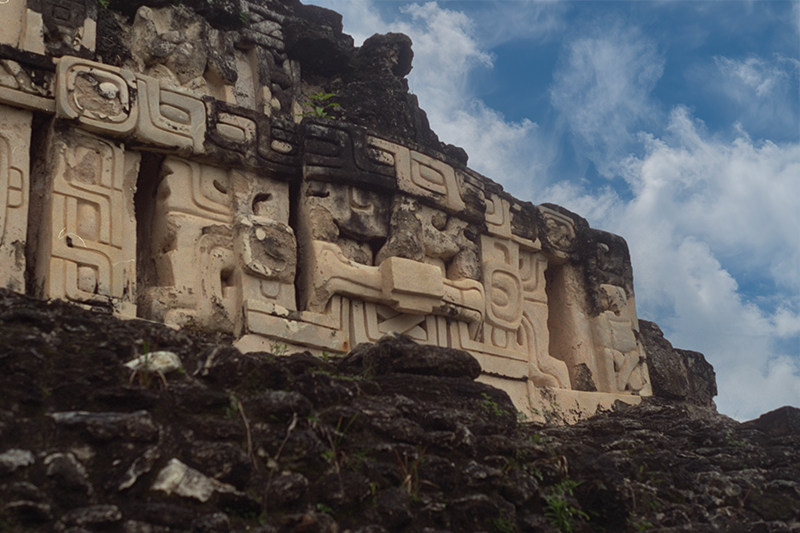
Photo by Marion Canavan
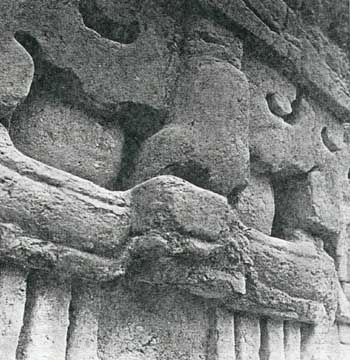
This photograph, xeroxed from an article by Linton Satterthwaite in Archaeology from 1950, shows the wonderful roman nose which has since degraded.
Satterwaite writes: "Here one looks up and from the side at the eyes and nose of the god thus associated with the moon and, less directly, with the sky and the planet Venus.
The upper lip projects outward at the center, and from this projection it is possible and perhaps probable that two human incisor teeth hung down, notched on the sides.
The human nose is of a Roman type and the eye-sockets are more or less rectangular.
All these features suggest the Maya sun god. However, the mouthful of enormous stylized fangs and the absence of a lower jaw suggest that this is too simple an interpretation.
(Satterthwaite 1950: 221)
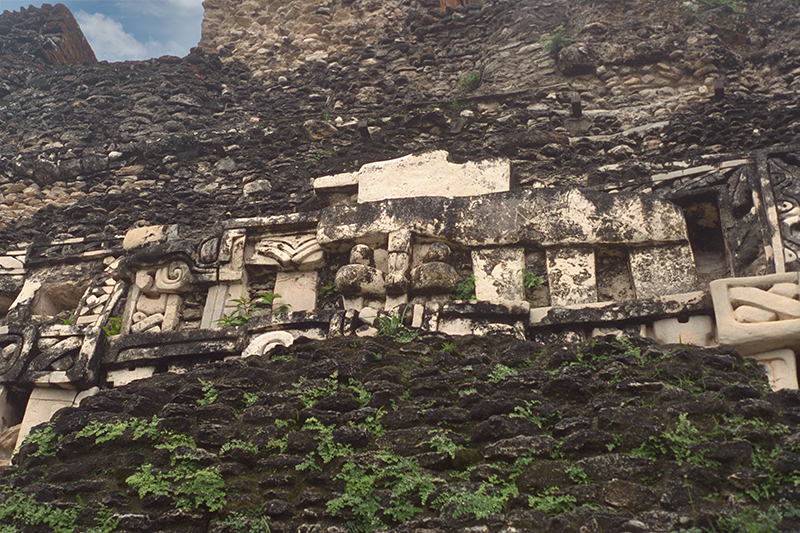
Photo courtesy of Marion Canavan
In the center of this photograph are the remains of a figure seated on a throne, surrounded by pillars. His legs and arms are still intact.
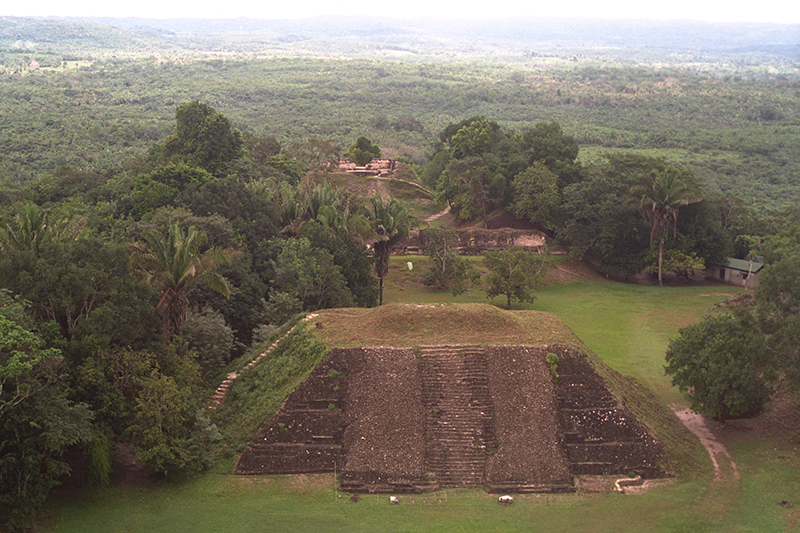
Differences in the height of their structures was significant to the Maya and gave a heirarchial sense of importance to their most lofty structures.
The Maya either selected naturally occurring higher ground for their most important structures, or they built them atop artificially created mounds. Looking down from the heights of El Castillo, it is easy to see how they differentiated their ceremonial space in this way.
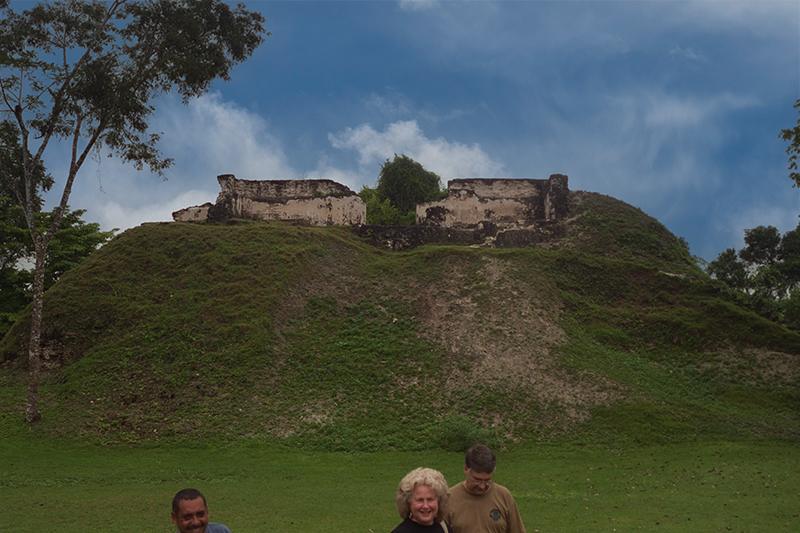
This is Marion, the brains and organizer behind our trips, with our friend Jeff, the high altitude photographer who gives me photos from the dizzy heights of the tallest pyramids, and our fearless guide Raul.
"Work at Benque Viejo was done by a Cambridge University party under Euan Mackie during late 1959 and early 1960.
The vaulted palace, A-11, was cleared as was a smaller residence or palace, A-15. Both building were found in a collapsed condition, and certain features revealed in the excavations lead Mackie to believe that their destruction was very sudden.
He postulates either destructive human action or an earth tremor, favoring the latter explanation. Of special interest is the ceramic depositional evidence. Seventeen vessels of the Benque Viejo IIIB complex were found smashed on the floor of A-11 by the falling vault stones."
Willey, Ballard, Glass & Gifford, 1965: p. 315
"Investigation of the confused mass of ruins of the main edifice [Structure A-6 in the background] showed that in the earliest time the structure consisted of a single story with rooms on all four sides, but naturally those on the north and south were specially favored, since the principal facades faced north and south.
This oldest building was, however, in a later epoch filled up with stones (a frequent occurence in Maya buildings) and a second story was erected upon the first, with stairways on the north and south.
From all the four slopes of the eminence artificially prepared for architectural purposes, chambers, terraces, stairways, etc., had once been thrown out, but these have now been totally destroyed by the tropical vegetation.
Near the southeast corner [right side of the photo] there are, however, the ruins of a narrow, vaulted passage, leading from south to north through the substructural mass [south side of the building shown in this photo]. This narrow passage is filled up to half its height with debris, and in this debris I found many sherds of beautiful pottery vessels, fiery yellow and red in color."
(Teobert Maler 1908: 77-78)
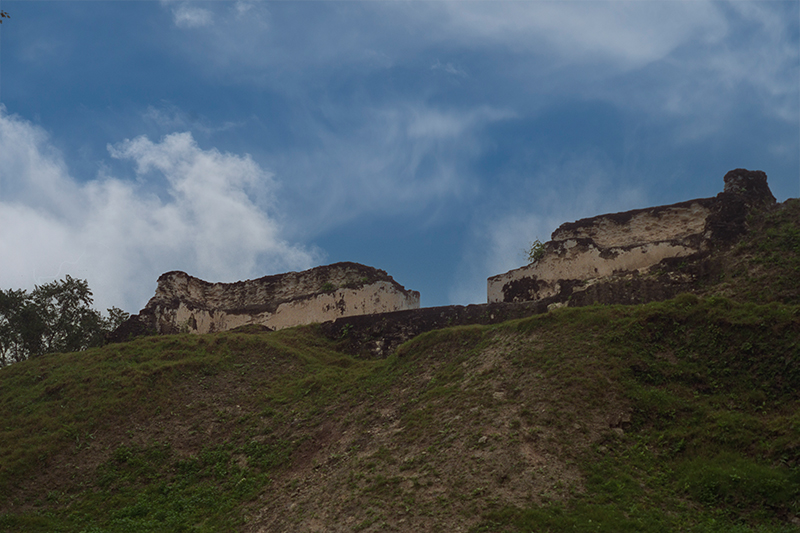
"In its original form Structure A-11/1 contained four rooms, a double one facing south (nos. 1 and 2), with a central passage between them, and two lateral rooms (nos. 3 and 4) facing west and east respectively.
A broad, level terrace, perhaps 8 ft. (2.4m) wide as already suggested, must have connected the western, southern and eastern doorways; rooms 3 and 4 doubtless faced the main stairways which led up to this.
The doorways to rooms 3 and 2 were 7 ft (2.13m) and 6 ft (1.83m) wide respectively. There were of course no actual doors in these openings; the complete rim of a storage jar was found set into the inside face of the wall of room 3, 9 in (23cm) from the edge of the door.
This is interpreted as one of a pair of curtain tie-holes (the south side of this doorway has vanished) in each of which there was presumably once a stick with a cord tied to it. The curtains could thus have been tied back from the opening as required. This feature was not found in the interior doorways."
Mackie, 1961: 31

